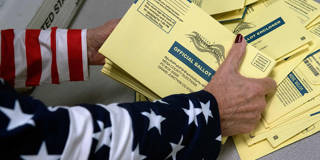American voters are more polarized than ever before, and the United States' conventional electoral system prevents a third-party candidate from posing a serious challenge, even if he or she can bridge ideological and partisan divides. But it does not have to be this way: a simple and sensible institutional fix is readily available.
TUCSON/CAMBRIDGE – More than ever before, Americans are dissatisfied with their two main political parties, the Democrats and the Republicans. In a recent Gallup poll, 63% of respondents – the highest percentage ever – said “a major third party is needed.”
Yet with voters so polarized, America’s conventional first-past-the-post electoral system (each voter casts a ballot for a single candidate, and the candidate with the most ballots wins) prevents a third-party candidate from posing a serious challenge, even if he or she can bridge ideological divides. Democratic voters may greatly prefer a third-party candidate to the Republican, but they will still cast their ballot for the Democrat given their strong partisan preferences; Republican voters will act symmetrically, in the opposite direction. Only a sliver of independent swing voters will end up voting for the third party.
Fortunately, a variant of California’s top-two system would solve this problem and allow a moderate third-party candidate – a nominee offering a compromise between political extremes – to compete successfully. As in California, all candidates – regardless of political affiliation – would compete in a nonpartisan primary, with each voter casting a ballot for one of them. But, unlike in California, the top three (rather than the top two) vote-getters would advance to the general election.

TUCSON/CAMBRIDGE – More than ever before, Americans are dissatisfied with their two main political parties, the Democrats and the Republicans. In a recent Gallup poll, 63% of respondents – the highest percentage ever – said “a major third party is needed.”
Yet with voters so polarized, America’s conventional first-past-the-post electoral system (each voter casts a ballot for a single candidate, and the candidate with the most ballots wins) prevents a third-party candidate from posing a serious challenge, even if he or she can bridge ideological divides. Democratic voters may greatly prefer a third-party candidate to the Republican, but they will still cast their ballot for the Democrat given their strong partisan preferences; Republican voters will act symmetrically, in the opposite direction. Only a sliver of independent swing voters will end up voting for the third party.
Fortunately, a variant of California’s top-two system would solve this problem and allow a moderate third-party candidate – a nominee offering a compromise between political extremes – to compete successfully. As in California, all candidates – regardless of political affiliation – would compete in a nonpartisan primary, with each voter casting a ballot for one of them. But, unlike in California, the top three (rather than the top two) vote-getters would advance to the general election.